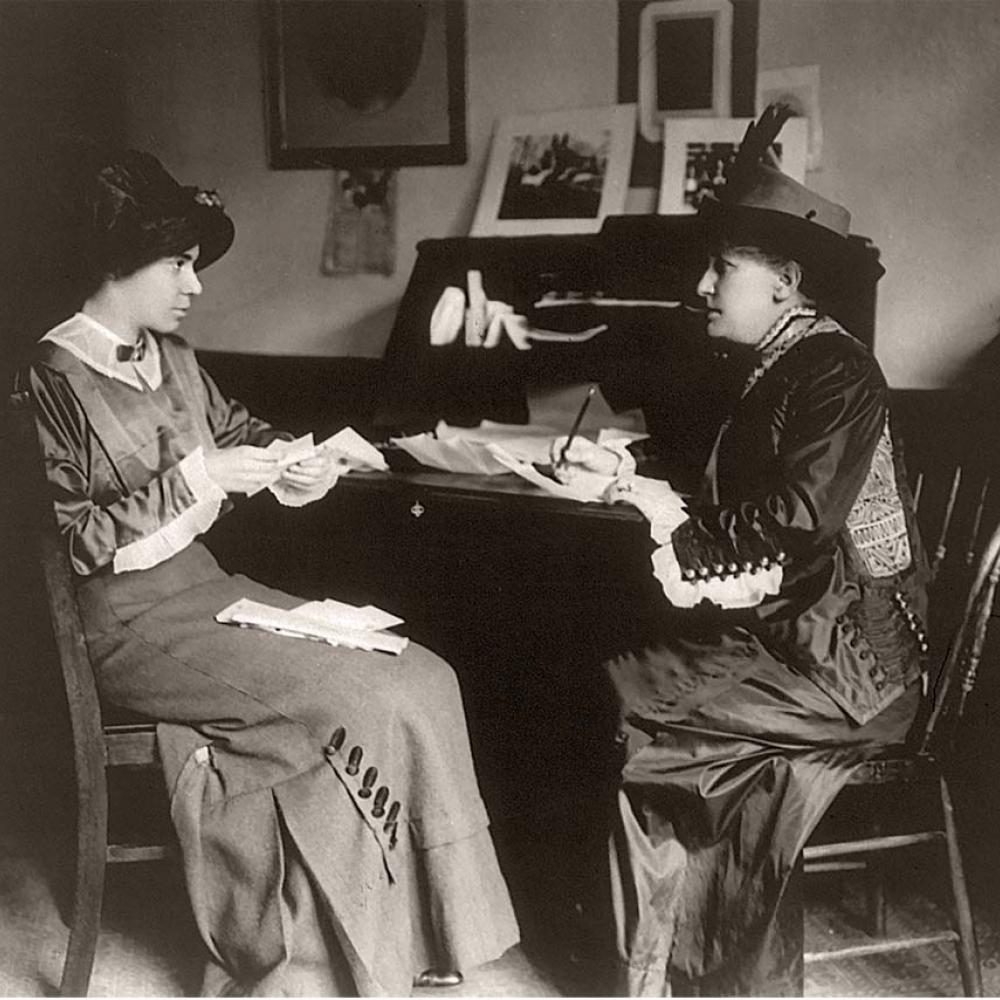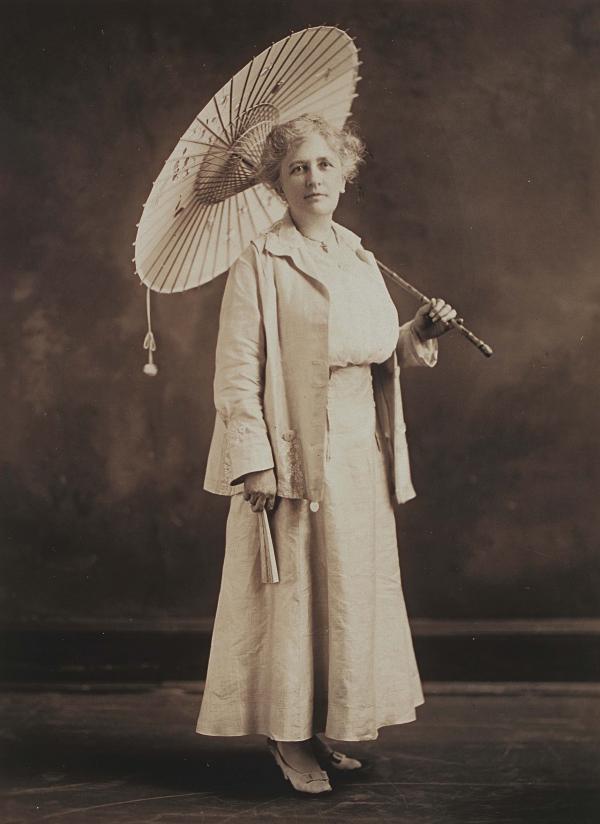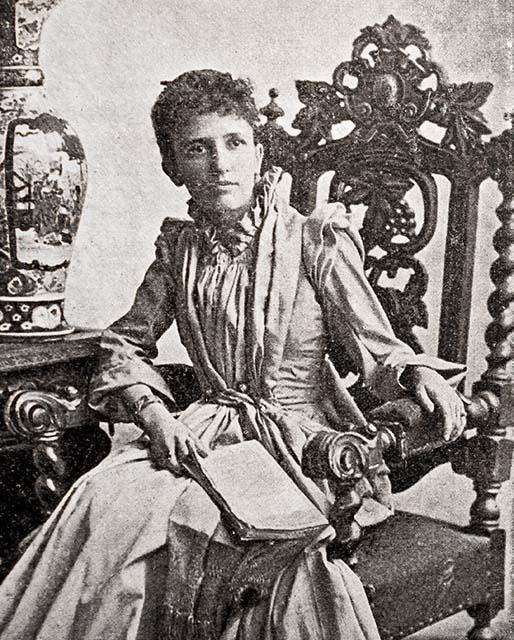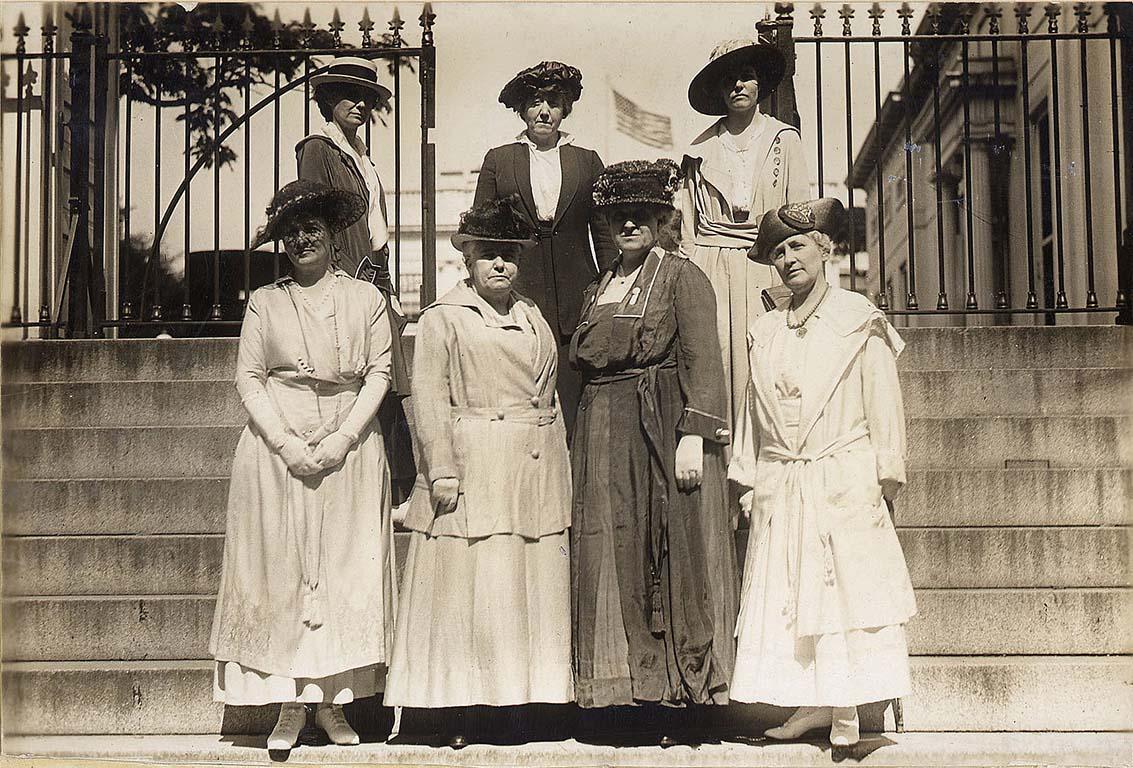In 1916, after wintering in California and a pit stop in Chicago for the Republican National Convention, the highly respected suffragist Helen Hamilton Gardener returned to Washington, D.C. It was early summer, and her arrival was quite the occasion. Ladies “in official, Army and legal circles,” reported the Washington Herald, celebrated her homecoming with a “prettily appointed luncheon” at the University Club. Over tea and tiny sandwiches, they filled her in on the season’s news, including the fact that younger suffragists, led by Gardener’s former colleague Alice Paul, had been heckling (yes, heckling) the president in the name of women’s rights. On July 4, these same young women had even disrupted Wilson’s speech at the dedication of the new American Federation of Labor Building. Such temerity shocked Gardener, and she felt she ought to do something to lessen its effect.
After taking the night to think it over, she sat down at the typewriter in her home office at 1838 Lamont Street, N.W., a tastefully appointed row house less than three miles from the White House. With the sounds of the animals at the National Zoo in the background, Gardener typed out a letter introducing herself to Joseph P. Tumulty, President Woodrow Wilson’s executive secretary, and expressing her astonishment at the young firebrands who, she wrote, did not represent “the real suffragists of America.”
Gardener enclosed an “outpouring of my wrath,” decrying the Congressional Union (soon to become the National Woman’s Party) and explaining the differences between Alice Paul’s group and her own, the National American Woman Suffrage Association (NAWSA). “No one more sincerely regrets, deprecates, and opposes the heckling of the President,” Gardener stressed, “than the real suffragists of America who have carried the woman suffrage banner, with dignity and good sense, from the early days to its splendid showing of complete triumph in twelve states and its promise of very early success in several others.”
Along with her missive, Gardener included her calling card, a photo, a list of references, and a 1915 NAWSA letterhead listing her position, “since you may never have heard of me.” She emphasized her political contacts, noting that “if you wish to ask Senators Williams, Sutherland, Thomas, Smoot or Representatives Taylor (Col.), Champ Clark (or his secretary Mr. Bassford) you will find who and what I am.” Who and what she was had varied greatly according to each decade of her life. This letter to Tumulty contained no clues that Gardener, by then an elegant sixty-three-year-old woman, had once been a young firebrand herself or that she harbored a secret, scandalous past.
Of the scores of letters that Tumulty and Wilson regularly received from various factions of local, state, and national suffragists, Gardener’s note stood out. Perhaps it was because her letter was typewritten and easily legible. Perhaps it was her telltale charm, honed over decades of writing such letters to powerful men. Or perhaps her letter stood out because, rather than ask Tumulty for a favor, her memo provided something useful for him. Whatever the reason, Gardener’s letter made an impression on the White House and distinguished her from the many other women who wrote the president to demand the vote.
Several days after Gardener introduced herself to Tumulty, NAWSA president Carrie Chapman Catt requested a meeting with the president to ascertain his thoughts on the newly approved Democratic party platform, which included a statement in support of suffrage, but only if granted state by state. Before accepting Catt’s request, Wilson pressed Tumulty for more information about the women of NAWSA. “Are these ladies of the ‘Congressional Union’ variety?” the president inquired. Even after more than three years in office and multiple meetings with suffrage groups, Wilson still could not distinguish the various suffrage factions, nor did he realize that NAWSA was the nonpartisan, national voice of women suffragists. Drawing on Gardener’s instructive July 5 letter, Tumulty assured the president that these women were not of the “‘heckling’ variety” (Gardener’s letter was later inserted into the Congressional Record to help congressmen differentiate between suffragist groups).
Wilson gladly accepted the meeting: “OK Tuesday at 2 p.m.— office.” Between that initial meeting in the summer of 1916 and the close of 1917, Gardener befriended the president, his wife, and his top aides, and became a welcome, daily presence in the White House. Patiently, over the course of eighteen months, Gardener nudged the president from an opponent of the federal suffrage amendment (he initially supported women voting, but only if the vote was granted on a state-by-state basis) into the Susan B. Anthony Amendment’s most powerful ally.
This was not the first time Gardener had relied on her wits and personal charm to accomplish a seemingly impossible task. To the contrary, doing so was the story of her life. In fact, Helen Hamilton Gardener was not even her real name. She was born Alice Chenoweth in Winchester, Virginia, in 1853, to a slave-owning Methodist preacher who emancipated the people he held in bondage and later served as a Union scout at the personal behest of President Abraham Lincoln, much to the dismay of his Virginian friends and neighbors. Young Alice grew up lionizing those who sacrificed for their ideals, no matter the cost.
After watching her older sisters and sisters-in-law bear and bury babies, Alice decided that traditional marriage was not for her. So, at the age of nineteen, she moved to Cincinnati to become a teacher. By twenty-one, she was the youngest school principal in Ohio. Her skill and beauty brought her to the attention of the Ohio commissioner of common schools, who began paying an inordinate amount of attention to the schools in Sandusky, where she was then living. By the summer of 1876, newspapers across the state published stories about the affair the young principal was having with the married school commissioner. Alice lost her job and was run out of town. It would be nearly fifty years before she again received a regular paycheck.
Over the next six years, Alice questioned why men and women were held to such different standards when it came to sex, and she began writing down her ideas. “A man is valued of men for many things, least of which is his chastity,” she later observed. “A woman is valued of men for few things, chief of which is her chastity. This double code can by no sane or reasonable person be claimed as woman made.” She came to believe that the Bible was the root cause of women’s oppression and of the sexual double standard. From afar, she followed the career of Robert Ingersoll, the Civil War veteran and lawyer, who was known as the “Great Agnostic” for his passionate lectures, which drew crowds of ten thousand and more. If Ingersoll could make a living by speaking out against Christian orthodoxy, why couldn’t she?
In 1883, Alice moved to New York City and changed her name to Helen Hamilton Gardener, leaving the public record of her affair far behind. She sent Ingersoll, a man who was known to welcome all callers, drafts of her writing, no doubt accompanied by a charming cover letter. Ingersoll assured her that she “had written something valuable” and “at once declared it must be read in public.” He even helped arrange Gardener’s first public talk, held in January 1884 at New York City’s Chickering Hall, and traveled to Manhattan to introduce her. Ingersoll was then at the pinnacle of his national fame, and his presence guaranteed an inordinate amount of press coverage and ticket sales for a young woman lecturer no one had ever heard of before.
“It is thought strange and particularly shocking by some persons for a woman to question the absolute correctness of the Bible,” Gardener began her debut lecture. “She is supposed to be able to go through this world with her eyes shut, and her mouth open wide enough to swallow Jonah and the Garden of Eden without making a wry face. It is usually recounted as one of her most beautiful traits of character that she has faith sufficient to float the Ark without inspecting its animals.” But Gardener was not like these other women. “I claim that I have a right to offer my objections to the Bible,” she announced. Newspapers across the country covered this remarkable lecture and dubbed Gardener “Ingersoll in Soprano.”
From the podium at Chickering Hall, Gardener graduated to multistate lecture tours, published seven books and countless essays, and expanded her reach far beyond free-thought circles. By 1893, she was one of the most revered women in America. That summer, she delivered more speeches at the landmark World’s Fair in Chicago than any other American woman. The New York Sun reported that after Susan B. Anthony, Gardener created “the profoundest sensation.”
Between her 1884 reinvention and her move to Washington, D.C., in 1907, Gardener charted an autonomous life. She earned the nickname the “Harriet Beecher Stowe of Fallen Women” for her bold efforts to raise the age of sexual consent for girls (in 1890, it was twelve or younger in 38 states). She suffered many private tribulations, enjoyed adventures in 22 countries, and reinvented herself once more.
By the time she introduced herself to Joseph Tumulty in 1916, Gardener was a popular D.C. socialite, the wife of a Civil War hero, and a next-door neighbor to the speaker of the House of Representatives, “Champ” Clark, Democrat of Missouri. For her skillful lobbying of congressmen, her NAWSA colleagues referred to her as their “diplomatic corps.” Besides her work with Congress, Gardener’s signature diplomatic achievement was the way she infiltrated the Wilson White House.
After her initial visit in the summer of 1916, Gardener stopped by the White House and called on the telephone several times each week. With this regular contact with Wilson during his second term, she positioned herself as providing insider information on suffrage and Democratic politics in the South. (Wilson was the first Southern Democrat to be elected president since the end of the Civil War, and Democrats took control of both Houses of Congress in the 1912 election.) Ultimately, Wilson’s staff came to view her as a partner and collaborator, not as a pesky supplicant. She sent apricots from her garden, effusive thank-you notes, and a heartfelt letter when Tumulty’s father died. Even NAWSA president Carrie Chapman Catt generally did not approach Wilson without first going through Gardener.
NAWSA Congressional Committee chair Maud Wood Park recalled that Gardener’s work with the White House proved invaluable during this final push in Congress. As NAWSA’s White House emissary, “she was vastly better than anyone else,” Park explained. “She was the one woman to whom the President was always willing to grant an appointment and whom Mr. Joseph Tumulty and Mr. Rudolph Forster, the secretaries in the executive office, were always glad to assist.” Gardener later boasted that she had asked the president for twenty-two favors and been granted twenty-one. The one favor Wilson didn’t grant? He refused to appoint Carrie Chapman Catt to the international peace commission negotiating the end of World War I, blaming it on the other countries, saying they would never agree to have a woman on the commission.
For example, at Gardener’s behest, Wilson summoned to the White House the Democratic members of the House Committee on Woman Suffrage (which she proved instrumental in establishing) on January 9, 1918, the eve of the first House vote on the Nineteenth Amendment, to urge them to vote “yes.” Following the meeting, Wilson publicly signaled his support of the amendment by agreeing to release his private statement, which he wrote in pencil in his own hand, to the press. Tumulty immediately phoned Gardener to share the momentous news and promised to save the scrap of paper for her, a thoughtful testament to their close working relationship. She “thanked him from the bottom of [her] heart for thinking of it” and asked him to please “not fold it” and “ask [the president] to sign it and let me have it just as it is.” Gardener predicted that the president’s statement would be a “historic document,” but it remains in an obscure folder in Tumulty’s papers at the Library of Congress.
On January 10, the House narrowly passed the Susan B. Anthony Amendment, but then it languished in the Senate. For the next eighteen months, Gardener worked closely with the White House in an attempt to convert a few additional “yes” votes in the upper chamber. Gardener provided the president with NAWSA’s tallies of senators who were for suffrage, against, and “doubtful,” so that he could channel his influence accordingly. Every time Gardener got a lead on a Democratic senator who might be swayed, she nudged Tumulty to get the president to reach out to the man in question, and each time Wilson did as instructed.
Over the course of 1918, Gardener grew bolder. In addition to giving the White House names of senators for the president to contact, she also began providing talking points about how the president might push for suffrage as a war measure. And the White House started sharing copies of the president’s letters to senators with Gardener, sometimes while the ink was still wet. At one point, she even sent a bulleted to-do list for the president. Summoning her literary humor, Gardener penned a July 4 poem to the president, which she claimed, tongue in cheek, had been written by a soldier on the front:
We’ll fight with all that’s in us / for justice to all mankind, / but it takes our nerve and riles us, / to know that such men behind / can bully and flout our women / who ask but their honest due— / so we’re asking, Woodrow Wilson, / for another blast from you!
Gardener was literally trying everything she could think of to get the amendment through the Senate before the Sixty-Fifth Congress adjourned.
By September 1918, NAWSA leaders believed they were just one vote shy in the Senate. Gardener arranged a meeting at the White House where the suffragists implored the president to issue a public statement demanding that the Senate pass the Nineteenth Amendment as a war measure. “The hope and the fate of the women of the nation rest in your hands,” Catt declared.
With the proud, indulgent tone of someone bearing a great and unexpected gift, the president replied to Catt, “I did not do what [your letter] suggested, but I hope that you think what I did do was better.” On September 30, Wilson went to the Capitol to address the entire Senate, for only the second time in his presidency, accompanied by all but one member of his cabinet. Wilson told the senators that passage of the Susan B. Anthony Amendment was “vitally essential to the successful prosecution of the great war of humanity in which we are engaged.”
Heeding the president’s call, the Senate scheduled a vote on the amendment for the very next day. However, most Senate opponents did not buy the president’s war measure argument; to them, the Nineteenth Amendment had nothing to do with World War I and everything to do with black citizens voting in the South. Senators feared that not only would the Nineteenth Amendment enfranchise black women, it might also compel the federal government to uphold the Fifteenth Amendment, which guaranteed the vote to black men but had not been enforced since the Compromise of 1877.
Throughout 1918, NAWSA leaders, with the cooperation of the White House, tried to turn a few more votes their way, but they kept running into what Catt described as “the Southern Wall of Opposition.” For example, suffragists hoped that Mississippi Democrat John Sharp Williams, whom Park referred to as “the most erudite man” in the Senate, might change his vote. Williams was good friends with Gardener, and she began to lobby him immediately after House passage.
In one of her signature letters, Gardener first inquired about Mrs. Williams, reminding the senator that they had celebrated her birthday dinner together the year before. Then she laid into him. “Did you analyze the vote on Suffrage in the House?” Did you, she pressed, notice that 23 state delegations were united in support of the amendment and only six states, including Mississippi, were solidly opposed? “I want you to redeem that state,” she implored. “You are by far its leading citizen.” Do not, she beseeched him, “insist upon remaining with a sinking ship,” when everyone could see that “Democracy’s hour has struck” for women.
The following day, Senator Williams sent his “Dear Friend” a candid reply: “If anything in the world could make me do the thing you want done it would be your letter.” But even though he realized that women’s suffrage was on the horizon, he could not do as Gardener wished. Mainly, Williams divulged, he could not vote for the Susan B. Anthony Amendment because it would, at least on paper, enfranchise the black women of Mississippi. This he could not abide, even if it meant disenfranchising his daughters and offending Gardener. If he lived in “any white state,” Williams acknowledged, he would vote for suffrage, but not in Mississippi. Black women, he charged, “cannot be controlled, as the men can be, and they would almost all, without exception, go to the polls while a great many white women would not.”
Referring to the “injurious” Fifteenth Amendment, Williams clarified that he considered the vote a privilege, not a right, and that it should be up to each individual state to determine who could cast a ballot. He then returned explicitly to race. “Of course, you know as well as I do, and if you do not I will tell you confidentially, that the real reason why negro men do not vote in the State of Mississippi, is not because of their legal disqualifications, but because they are afraid that if they do vote some of them might get hurt.” But such violent intimidation would not work with black women because “a woman is a woman after all, whether she be black or white.” And even if “a few men of the very lowest sort” did use violence to scare black women from the polls, the “whole moral sense of the world would be set against the Mississippi white man.”
Following Wilson’s September 1918 address to the Senate, Williams introduced a proposal to limit the Nineteenth Amendment to white women. It failed to carry. Gardener later described Williams as a man with a “splendid” feeling for democracy as a “fundamental principle,” but whose aristocratic blood and “slave-holding states’ rights traditions tone down and modify certain of the fundamentals just as they did with Washington and Jefferson.” The next day, the Senate fell short of passing the Susan B. Anthony Amendment by two votes. With “heads held as high as we could get them,” Gardener, Park, and Mary Hay (of New York) went to thank their friends in the Senate for their help. More disappointed than at any previous defeat, Carrie Chapman Catt vowed never again to watch another vote.
After the defeat in October and the promising November 1918 elections in which the suffragists ousted two Senate foes even though they themselves could not vote, NAWSA members spent the winter frantically canvasing the incoming Sixty-Sixth Congress. The numbers in the Senate were still too close for comfort. While the women counted just enough “yes” votes, their slim margin meant that one illness or one changed mind could signal another defeat. On April 30, 1919, as the president prepared to return from negotiating the end of World War I in Paris for the opening of Congress, Tumulty cabled to let him know that his suffrage contacts, no doubt Gardener, informed him that they needed one more vote in the Senate. Tumulty suggested that Wilson track down Sen. William Harris of Georgia, who was also in Paris, and convince him to issue a public statement saying that he would deliver the vote. Senator Harris issued the statement as requested.
Wilson then dispatched a message to Congress, urging members to pass the suffrage amendment, immediately upon convening, as part of his larger postwar agenda. The Sixty-Sixth Congress assembled on May 19. Rep. James Mann, Republican of Illinois, who had come from his hospital bed to vote “yes” the previous January, assumed the chairmanship of the House Committee on Woman Suffrage. He assured a nervous Maud Wood Park that he had all the necessary votes lined up and that he intended to make the Susan B. Anthony Amendment the very first item on the House agenda. Two days later, he did.
On June 4, the Senate scheduled a vote on the amendment. The heat was oppressive that day, and the discussion dragged on and on. Democratic senator James Reed of Missouri delivered a three-hour filibuster about states’ rights. And Sen. Pat Harrison, Democrat of Mississippi, introduced a measure to exclude black women from voting. Sen. Ellison “Cotton Ed” Smith, Democrat from South Carolina, summarized the opposition when he protested that “the southern man who votes for the Susan B. Anthony Amendment votes to ratify the Fifteenth Amendment.”
Finally, the vote was called. At 5:15 p.m., Senate president pro tempore Albert Cummins announced that the amendment had carried 56 to 25, narrowly meeting the two-thirds majority. In addition to the two “yes” votes the suffragists picked up in the 1918 election, Senator Harris kept his promise to Wilson, and Sen. Frederick Hale of Maine changed his vote to “yes” after Mainers agreed, in 1918, to let women vote in presidential elections. Speaking for the Southern Wall of Opposition, Sen. Edward Gay of Louisiana bitterly declared that “thirteen states will never vote for this measure unless you amend it to spare the South the problem of the negro woman vote.”
After the vote was announced, the Senate floor and galleries erupted in cheers and “deafening applause” lasting two straight minutes. The New York Tribune reported that the suffragists “indulged in a good old fashioned feminine kissing and hugging bee.” But Helen Hamilton Gardener could not spend much time celebrating. She had to rush to the official signing ceremony that she herself had planned, down to purchasing the fancy gold pen that the speaker of the House and the vice president used to sign the Nineteenth Amendment before sending it off to the states for ratification.
Adapted from Free Thinker: Sex, Suffrage, and the Extraordinary Life of Helen Hamilton Gardener by Kimberly A. Hamlin. Copyright © 2020 by Kimberly A. Hamlin. With permission of the publisher, W. W. Norton & Company, Inc. All rights reserved.




